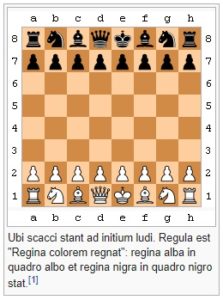Before it isn’t the 20th any longer (soon, where I am), I wish all of you a happy International CHESS Day!
In honor of this esteemed occasion, I repost…
Animi caussa… the names of the pieces.
- 1 rex, sive scaccus
- 1 regina (vel virgo, vel amazon, vel domina), sive dama (unde damicus ludus), vel fercia
- 2 turres, vel elephantes, sive rochi
- 2 episcopi (vel satellites, vel signiferi, vel cursores, vel sagittiferi), sive alfīni
- 2 equites
- 8 pedites, vel pedini, sive pedones.
And how does the regina move, you ask?
Regina est potentissima omnium militum. Ei sunt potestates et episcopi et turris. Potest moveri passim quemlibet numerum quadratorum prorsum (sive sursum), rursum (sive deorsum), dextrorsum, sinistrorsum, et quemlibet in obliquum.
There are also descriptions of the history of the game, the notation for recording moves, etc.
If you are at all interested in chess and Latin, check it out.



































In Chapter 16 of The Way of Perfection St. Teresa of Avila draws an analogy between the tactics deployed playing the chess pieces with the development of our interior life. She makes it clear that some may reprove her for talking about games “as we do not play them in this house and are forbidden to do so.” But, in true Teresian style, she goes on to state that this “will show you what kind of a mother God has given you — she even knows about vanities like this!” St. Teresa proceeds to use the game to demonstrate that knowledge of the rules — of chess or the interior life — is not enough in itself to acquire a final “checkmate.”
“Contemplation, daughters, is another matter. This is an error which we all make: if a person gets so far as to spend a short time each day in thinking about his sins, as he is bound to do if he is a Christian in anything more than name, people at once call him a great contemplative; and then they expect him to have the rare virtues which a great contemplative is bound to possess; he may even think he has them himself, but he will be quite wrong. In his early stages he did not even know how to set out the chessboard, and thought that, in order to give checkmate, it would be enough to be able to recognise the pieces. But that is impossible, for this King does not allow himself to be taken except by one who surrenders wholly to him.”
It is probably because of this that St Teresa is the patron saint of chess players.
Interesting. Thanks Fr. Z and Fr Richard Duncan CO.
“This is a nicely written and finely illuminated manuscript of one of the great classics of late medieval literature, Jacobus of Cessolis’s Game of Chess, using chess as a framework for a moral allegory of society.”
https://www.textmanuscripts.com/medieval/cessolis-liber-de-moribus-60910
King Alfonso X of Castile and Leon also commissioned some sort of chess manuscript. There is a variant using a 12×12 board, and pieces include crocodiles, griffins, and giraffes. God willing, the Chicken of Bristol is included.
https://www.chessvariants.com/historic.dir/acedrex.html